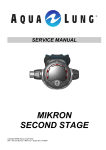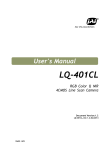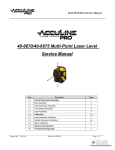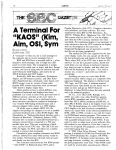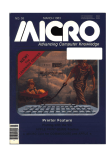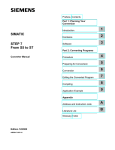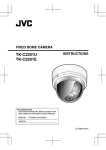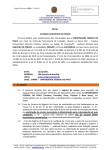Download LT-400CL Manual
Transcript
User's Manual LT-400CL 3CMOS High Speed Color Line Scan Camera Document Version: Ver.1.0 LT-400CL_Ver.1.0_June2010 1011E-0909 LT-400CL Notice The material contained in this manual consists of information that is proprietary to JAI Ltd., Japan and may only be used by the purchasers of the product. JAI Ltd., Japan makes no warranty for the use of its product and assumes no responsibility for any errors which may appear or for damages resulting from the use of the information contained herein. JAI Ltd., Japan reserves the right to make changes without notice. Company and product names mentioned in this manual are trademarks or registered trademarks of their respective owners. Warranty For information about the warranty, please contact your factory representative. Certifications CE compliance As defined by the Directive 2004/108/EC of the European Parliament and of the Council, EMC (Electromagnetic compatibility), JAI Ltd., Japan declares that LT-400CL complies with the following provisions applying to its standards. CISPR Pub.22 (Emission) CISPR Pub.24 (Immunity) IEC61000-4-2 Conforming Level 4 (Electrostatic discharge immunity test) FCC This equipment has been tested and found to comply with the limits for a Class B digital device, pursuant to Part 15 of the FCC Rules. These limits are designed to provide reasonable protection against harmful interference in a residential installation. This equipment generates, uses and can radiate radio frequency energy and, if not installed and used in accordance with the instructions, may cause harmful interference to radio communications. However, there is no guarantee that interference will not occur in a particular installation. If this equipment does cause harmful interference to radio or television reception, which can be determined by turning the equipment off and on, the user is encouraged to try to correct the interference by one or more of the following measures: - Reorient or relocate the receiving antenna. - Increase the separation between the equipment and receiver. - Connect the equipment into an outlet on a circuit different from that to which the receiver is connected. - Consult the dealer or an experienced radio/TV technician for help. Warning Changes or modifications to this unit not expressly approved by the party responsible for FCC compliance could void the user’s authority to operate the equipment. 2 LT-400CL Supplement The following statement is related to the regulation on “ Measures for the Administration of the control of Pollution by Electronic Information Products “ , known as “ China RoHS “. The table shows contained Hazardous Substances in this camera. mark shows that the environment-frien dly u se period of containe d Hazard ous Substances is 15 years. 嶷勣廣吭並㍻ 嗤蕎嗤墾麗嵎賜圷殆兆各式根楚燕 功象嶄鯖繁酎慌才忽佚連恢匍何〆窮徨佚連恢瞳麟半陣崙砿尖一隈〇云恢瞳ゞ 嗤蕎嗤 墾麗嵎賜圷殆兆各式根楚燕 〃泌和 ・・・・・ ・・・・・ ・・・・・ ・・・・・ ・・・・・ ・・・・・ ・・・・・ 桟隠聞喘豚㍉ 窮徨佚連恢瞳嶄根嗤議嗤蕎嗤墾麗嵎賜圷殆壓屎械聞喘議訳周和音氏窟伏翌 亶賜融延、窮徨佚連恢瞳喘薩聞喘乎窮徨佚連恢瞳音氏斤桟廠夛撹冢嶷麟半 賜斤児繁附、夏恢夛撹冢嶷鱒墾議豚㍉。 方忖仝15々葎豚㍉15定。 LT-400CL - Contents – 1. 2. 3. 4. General ........................................................................................................ 5 Camera nomenclature ...................................................................................... 5 Main features ................................................................................................. 5 Locations and functions.................................................................................... 6 4.1. Main unit ................................................................................................ 6 4.2. Rear Panel and indicators ............................................................................ 7 Note: Factory default settings for both functions are “OFF”. ............................................. 7 5. Input and output (connectors, signals and circuits) ................................................... 8 5.1. 12-Pin Connector (Hirose) ............................................................................. 8 5.2. Digital Output / Interface Connectors for Camera Link ......................................... 8 5.3. Camera Link output ................................................................................... 9 5.4. Input and output circuits ............................................................................ 11 5.4.1 Trigger input ...................................................................................... 11 5.4.2 EEN/XEEN output (Exposure Enable ) ...................................................... 11 6. Functions and Operation.................................................................................. 12 6.1. Basic functions ........................................................................................ 12 6.2. Sensor layout and output timing ................................................................... 12 6.3. Key functions .......................................................................................... 13 6.3.1 Line rate (Command LR) ........................................................................ 13 6.3.2 Electronic shutter (Exposure) (Command PER, PEG, PEB) ................................. 13 6.3.3 EEN (Exposure Enable) function ............................................................... 14 6.3.4 White balance .................................................................................... 14 6.3.5 Gain control ....................................................................................... 15 6.3.6 Setup level ........................................................................................ 16 6.3.7 Knee correction .................................................................................. 17 6.3.8 PRNU (Pixel Response Non-Uniformity ) correction......................................... 17 6.3.9 DSNU (Dark Signal Non-Uniformity) correction .............................................. 18 6.3.10 Shading correction ............................................................................... 19 6.3.11 Binning ............................................................................................. 20 6.3.12 Sub-sampling ...................................................................................... 20 6.3.13 Windowing......................................................................................... 20 6.3.14 Test pattern generator .......................................................................... 20 6.4. Operation modes ..................................................................................... 22 6.4.1 No-shutter mode with internal trigger........................................................ 22 6.4.2 No-shutter mode with external trigger ....................................................... 24 6.4.3 Shutter-select mode with internal trigger ................................................... 26 6.4.4 Shutter-select mode with external trigger ................................................... 28 6.4.5 Pulse Width Control (PWC) mode .............................................................. 30 6.4.6 Compatibility of trigger modes and functions ............................................... 32 7. Configuring the camera ................................................................................... 33 7.1. RS-232C control ....................................................................................... 33 7.2. LT-400CL Command list ............................................................................. 34 8. Functions listed alphabetically by command acronyms ............................................. 39 8.1. Command AH – One-push AWB shutter ............................................................ 39 8.2. Command AHRS – Request status after One-Push AWB ......................................... 39 8.3. Command AL – Automatic Line Rate Reference Level .......................................... 39 8.4. Command AR – Automatic Line Rate setting ..................................................... 39 8.5 Command ARST – Auto reset mode ................................................................ 40 8.6 Command AW – Activate One-push Auto White Balance (AWB) - Gain ...................... 40 8.7 Command AWRS – Inquire the status after one-push AWB ..................................... 40 8.8 Command BA – Bit Allocation....................................................................... 40 8.9 Command BI – Binning (Horizontal only).......................................................... 41 8.10 Command BL – Master Black Level ................................................................ 41 3 LT-400CL 8.11 Commands BLR and BLB – Black level red and black level blue .............................. 41 8.12 Command BLM – Black level mode ................................................................ 41 8.13 Command EI – Interlocked R and B exposure with G ........................................... 41 8.14 Command GA – Gain level master / G channel.................................................. 42 8.15 Commands GAR and GAB – Red and blue gain levels ........................................... 42 8.16 Command GM – Gain mode ......................................................................... 42 8.17 Command KN – Knee ON/Off ....................................................................... 42 8.18 Commands KSR, KSG and KSB – Knee slope for R, G and B .................................... 42 8.19 Commands KPR, KPG and KPG – Knee point for R, G and B ................................... 42 8.20 Command LR - Line Rate (Scan Rate) ............................................................ 43 8.21 Command NR – Noise reduction ................................................................... 43 8.22 Command PBC – Select pixel black correction mode........................................... 43 8.23 Command PBR – Run pixel black correction and store to user area ......................... 43 8.24 Command PBS – Inquire the status of after pixel black correction .......................... 44 8.25 Command PER – Programmable exposure – Red................................................. 44 8.26 Command PEG – Programmable exposure – Green ............................................. 44 8.27 Command PEB – Programmable exposure – Blue ................................................ 44 8.28 Command PGC – Pixel gain correction mode .................................................... 44 8.29 Command PGR – Run pixel gain correction and store in user area........................... 45 8.30 Command PGS – Inquire the status after pixel gain correction............................... 45 8.31 Command SDC – Select shading correction mode ............................................... 45 8.32 Command SDR – Run shading correction ......................................................... 45 8.33 Command SDS – Request status after executing shading correction command ............ 47 8.34 Commands SGR,SGG,SGB – Gain Low, High ...................................................... 47 8.35 Command SRO – Sensor read out .................................................................. 47 8.36 Command TG – Trigger Origin...................................................................... 47 8.37 Command TI – Trigger input ........................................................................ 47 8.38 Command TP – Trigger polarity .................................................................... 48 8.39 Command TR – Trigger Mode ....................................................................... 48 8.40 Command TS – Test pattern ........................................................................ 48 8.41 Command WB – White Balance .................................................................... 48 9. Camera Control Tool for LT-400CL ..................................................................... 49 10. External appearance and Dimensions .................................................................. 52 11 . Specifications............................................................................................ 54 11.1 Typical data ............................................................................................ 54 11.2 Spectral sensitivity.................................................................................... 57 Appendix .......................................................................................................... 58 1. Precautions .............................................................................................. 58 2. Typical Sensor Characteristics ........................................................................ 58 3. Caution when mounting a lens on the camera ..................................................... 58 4. Caution when mounting the camera................................................................. 58 5. Exportation .............................................................................................. 59 6. References ............................................................................................... 59 Change History ................................................................................................... 60 User's Record ..................................................................................................... 61 4 LT-400CL 1. General LT-400CL is a 3CMOS line scan camera using three 4096 pixel line sensors mounted on a prism, for the R, G and B channels. It operates with an 80 MHz pixel clock, resulting in a maximum line rate of 16,180 lines per second. The camera outputs digital data in 3 x 8 bits or 3 x 10 bits format via Camera Link. The camera is configured by software through the serial communication port of the Camera Link interface, or via RS-232C through a 12-pin Hirose connector. The camera accepts M52 or F-mount lens. The latest version of this operation manual can be downloaded from www.jai.com . The latest camera control tool for the LT-400CL can be downloaded from www.jai.com . For camera revision history, please contact your local JAI distributor 2. Camera nomenclature The standard camera composition consists of: LT-400CL camera body with F mount Lens mount/sensor protection cap x1 x1 The camera is available in the following versions: LT-400CL-M52/-F Where L stands for “Linear sensor” family, T stands for “Tri sensor”, 400 represents the resolution “ 4000 pixels”, 400 represents variation with the same resolution and CL stands for “CameraLink®” interface. M52 stands for M52 lens mount version and F stands for the Nikon F mount version 3. Main features 3CMOS line scan camera with 4096 pixel resolution Dichroic RGB beam splitter prism 16,180 lines per second scan rate 80 MHz pixel clock 3 x 8 bits or 3 x 10 bits output through Camera Link interface Flat-field correction. Pixel-by-pixel compensation on each RGB channel Flat shading compensation Color shading compensation One-push white balance Knee correction Noise reduction circuit ON/OFF Pixel binning Sub-sampling readout Windowing readout Test pattern generator(color bar, gray, white) for set-up and troubleshooting Electronic shutter (for shutter selected modes) Lens mount is M52 as a standard and F mount as a factory option DC input range from +12 V to +24V Short ASCII commands for set-up via RS 232C or Camera Link Setup by Windows XP software 5 LT-400CL 4.1. Locations and functions Main unit ④ ③ ① DC IN / TRIG DIGITAL I / O - 1 ⑨ DIGITAL I / O - 2 4. ⑤ POWER/ TRIG W.B. SW1 ⑧ ⑦ ⑨ ② Serial No. FCC seal ⑥ Fig. 1 Location of external features 1 2 3 4 Camera Link base connector (1) (*Note1) Camera Link medium connector (2) (*Note1) 12-pin Hirose connector for DC +12, External trigger and RS-232C LED indicator Orange, steady: Initializing or one-push operation Green, steady: Operating, but not receiving external trigger Green, flashing: Operating and receiving external trigger 5 One-push auto white balance button 6 SW-1 (refer to chapter 4.2) 7. M52 lens mount (Note 2) 8 Nikon F-Mount lens mount(Note2) 9 Mounting holes 8 x M3, depth 5mm (*Note3) *Note1: When a Camera Link cable is connected to the camera, please do not excessively tighten screws by using driver. The Camera Link receptacle on the camera might be damaged. For security, the strength to tighten screws is less than 0.291 Newton Meter (Nm).Tightening by hand is sufficient in order to achieve this. *Note2: The rear protrusion of lens should be within 13mm for both M52 mount lens and Nikon-F mount lens. *Note3: The depth of mounting hole is 5mm ± 0.2mm. If the longer screws than 5.2mm are used, they may damage the circuit board inside. 6 LT-400CL 4.2. Rear Panel and indicators Rear panel indicator LED Push button DIP switch Fig.2 Rear panel LED There is a multi-color LED on the rear panel of the camera. It has the following functions: Green (Steady) Operating, but not receiving external trigger input Green (Flashing) Operating and receiving external trigger input. Note that the flashing frequency does not correspond to the frequency of the trigger signal. Note: In no-shutter/internal and shutter select/internal modes, this LED does not flash. Orange Initializing or executing one-push white balance Push button This push button is used for gain white balance. DIP switch SW-1 function No 1 2 Settings Function Serial communication Termination of External trigger ON Hirose 12Pin 75Ω Note: Factory default settings for both functions are “OFF”. OFF ON Serial Communication 75 Ω Fig.3 DIP switch 7 OFF Camera link (CC1) TTL LT-400CL 5. Input and output (connectors, signals and circuits) 5.1. 12-Pin Connector (Hirose) Type: HR10A-10R-12PB(71) Hirose (Male) Use the part number HR10A-10P-12S for the cable side Fig.4 5.2. Pin No. Signal 1 2 3 4 5 6 7 8 9 10 11 12 GND DC in GND Reserved GND RxD in TxD out GND XEEN out Trigger in NC GND Remarks +12V to +24V Do not connect RS-232C RS-232C TI=1, or set TI=0 for input via CL 12-pin Hirose connector Digital Output / Interface Connectors for Camera Link Type: 26P MRD Connector Fig. 5 3M 110226-1A10PL Camera Link connector This camera can be used with all Camera Link products that comply with the AIA Camera Link standard. Cables, transmission systems and frame grabbers/acquisition boards that do not comply with the Camera Link standard may work with this camera, but JAI Camera Solutions cannot be held responsible for loss in performance or damage of equipment, including the camera. Recommended cable assembly 3M 14B26-SZLB-XXX-OLC ( where XXX is the length of cable) The applicable cable length is 0.5m to 10m. 14B26-SZ3B-XXX-03V(small diameter type) and 14B26-SZ3B-XXX-04C(high flexion type) can be used but the length will be limited. Connector 1 (24Bit, 30 Bit) Pin No In/Out 1,14 2(-),15(+) 3(-),16(+) 4(-),17(+) 5(-),18(+) 6(-),19(+) 7(+),20(-) 8(-),21(+) 9(-),22(+) 10(+),23(-) 11,24 12,25 13,26 O O O O O I O I I Name Note Shield TxOUT0 TxOUT1 TxOUT2 TxClk TxOUT3 SerTC (RxD) SerTFG (TxD) CC1 (Trigger) CC2(Reserved) N.C N.C Shield GND 8 Data out Clock for CL Data out LVDS Serial Control Trigger GND LT-400CL Connector 2 ( Used only for 3 x 10 Bit output) Pin No In/Out Name 1,14 2(-),15(+) 3(-),16(+) 4(-),17(+) 5(-),18(+) 6(-),19(+) 7(+),20(-) 8(-),21(+) 9(-),22(+) 10(+),23(-) 11,24 12,25 13,26 O O O O O Shield TxOUT0 TxOUT1 TxOUT2 TxClk TxOUT3 N.C N.C N.C N.C N.C N.C Shield Note GND Data out Clock for CL Data out GND The LT-400CL follows the Camera Link standard in all respects. Please refer to the Camera Link version 1.1 specifications for detailed information on bit assignments of 24-bit RGB and 30-bit bit output. 5.3. Camera Link output RD9~RD0 : R Channel Camera Data(RD9=MSB, RD0=LSB) GD9~GD0 : G Channel Camera Data(GD9=MSB, GD0=LSB) BD9~BD0 : B Channel Camera Data(BD9=MSB, BD0=LSB) × : Not in use 9 LT-400CL Port/Signal 24bit Output 30bit Output Connector Pin Name 1 Port A0 RD0 RD0 Tx0 1 Port A1 RD1 RD1 Tx1 1 Port A2 RD2 RD2 Tx2 1 Port A3 RD3 RD3 Tx3 1 Port A4 RD4 RD4 Tx4 1 Port A5 RD5 RD5 Tx6 1 Port A6 RD6 RD6 Tx27 1 Port A7 RD7 RD7 Tx5 RD8 1 Port B0 GD0 Tx7 RD9 1 Port B1 GD1 Tx8 1 × Port B2 GD2 Tx9 1 × Port B3 GD3 Tx12 1 Port B4 GD4 BD8 Tx13 1 Port B5 GD5 BD9 Tx14 1 × Port B6 GD6 Tx10 1 × Port B7 GD7 Tx11 1 Port C0 BD0 BD0 Tx15 1 Port C1 BD1 BD1 Tx18 1 Port C2 BD2 BD2 Tx19 1 Port C3 BD3 BD3 Tx20 1 Port C4 BD4 BD4 Tx21 1 Port C5 BD5 BD5 Tx22 1 Port C6 BD6 BD6 Tx16 1 Port C7 BD7 BD7 Tx17 2 × × Port D0 Tx0 2 × × Port D1 Tx1 2 × × Port D2 Tx2 2 × × Port D3 Tx3 2 × × Port D4 Tx4 2 × × Port D5 Tx6 2 × × Port D6 Tx27 2 × × Port D7 Tx5 2 × Port E0 GD0 Tx7 2 × Port E1 GD1 Tx8 2 × Port E2 GD2 Tx9 2 × Port E3 GD3 Tx12 2 × Port E4 GD4 Tx13 2 × Port E5 GD5 Tx14 2 × Port E6 GD6 Tx10 2 × Port E7 GD7 Tx11 10 LT-400CL 5.4. Input and output circuits 5.4.1 Trigger input The External Trigger signal can be applied either through the Camera Link connector or at pin 10 of the 12-pin Hirose connector. The command to change this setting is TI (Trigger Input). TI=0 for Camera Link connector (factory default) and TI=1 for 12-pin Hirose connector. The input via the Fig. 6 Trigger input (12-pin Hirose) 12-pin Hirose connector is AC coupled. To allow long pulses, which may be required when using the Pulse Width Control (PWC) trigger mode, the input circuit is designed as a flip-flop circuit. The leading and trailing edges of the trigger pulse activate the circuit. The trigger input polarity can be changed by the command TP. At the 12-pin Hirose connector the External Trigger input is 4V ± 2V (TTL). It can be changed to 75 ohm termination by a DIP switch setting (SW 1) located on the rear panel. 5.4.2 EEN/XEEN output (Exposure Enable ) This output corresponds to the exposure (accumulation) time of the camera. It works with all operation modes. It is, however, not active when the test pattern function is enabled. The EEN signal is available at the Camera Link connector and at the 12-pin Hirose connector at the same time. At the Camera Link connector this signal has positive logic. At pin 9 of the 12-pin Hirose connector the signal has negative logic, and is therefore named XEEN. The output circuit is a 75 ohm complementary emitter follower. The Fig. 7 XEEN Circuit (12-pin Hirose) circuit is powered from the 5V supply, resulting in an output level of more than 4V. It is not terminated. 11 LT-400CL 6. 6.1. Functions and Operation Basic functions The LT-400CL is built around three high-performance CMOS line scan image sensors mounted on a prism block, as illustrated in Figure 7. Process circuits Camera link interface Sensor interface Auto black DSNU correction PRNU correction Shading correction Gain Line matrix User black setup Digital binning Camera link B a s e & Medium Fig.8 Sensor block diagram The incoming light is divided into three primary colors, Red, Blue and Green and transmitted to each sensor. The output from each sensor is LVDS and it is converted to parallel digital signals in the sensor interface. Each signal then is transmitted to processing circuits which manipulate in the necessary characteristics and output via the Camera Link interface. The functions in the processing circuits are described in the following sections. 6.2. Sensor layout and output timing The LT-400CL uses newly developed COMS sensors which have 4096 effective pixels. Light received on photodiodes is converted to electronic signals and these signals are handled in a correlated double sampling circuit, analog gain circuit and analog digital converter circuit. After that, digital signals are serialized and output. All those circuits are inside the sensor package. CMOS sensors can provide higher rates and lower power consumption than CCDs of equivalent resolution. 12 LT-400CL Fig.9 Fig.10 6.3. Sensor layout Video output timing Key functions 6.3.1 Line rate (Command LR) This function can set the line rate longer than 1L. Accordingly, it is possible to set the camera scan rate with the object running speed or to boost up the sensitivity by setting longer exposure time. Adjusting range: 61.8µs(1L) to 15.02ms Adjusting unit: 12.5ns Operation mode: TG=0 Internal trigger The line rate can be automatically configured (one-push auto line set) (Command:AR). This function will calculate and set the line rate of the camera based on the Automatic Line Rate Reference Level (Command :AL) and the scene illumination. 6.3.2 Electronic shutter (Exposure) (Command PER, PEG, PEB) This function sets the exposure time regardless of line rate setting. The exposure time can be set for red, blue, and green, respectively. Command PER= 4800 to 1194752 PEG= 4800 to 1194752 PEB= 4800 to 1194752 Adjusting range: 60μs (4800clk) to 14.93ms (1194752clk) (RGB individually) Adjusting unit: 12.5 ns (1clock) (RGB individually) Operation mode: Shutter select/internal trigger and shutter select/external trigger Note: Exposure time can be set as mentioned before. However, if the line rate is shorter than the exposure time, the accumulation time is determined by the line rate. This should be noted especially in external trigger mode. 13 LT-400CL Line rate > Exposure time Line rate (LR) = 20000 Tri gger ( I nternal /External ) Exposure R Exposure (Rch) =22000 Exposure G Exposure B In this case, although the expsore time is set at 22000, but the actual exposure time is limited by the line rate, 20000. Fig.11 Exposure setting should be less the line rate 6.3.3 EEN (Exposure Enable) function This function outputs the timing for image accumulation in all operating modes except test pattern output. The output can be through both the Hirose 12-pin and Camera Link connectors. The polarity of this output is negative from the Hirose 12-pin connector and positive from the Camera Link connector. These polarities cannot be changed. Tr i gger (I nternal /External ) Exposur e R Exposur e G Exposur e B EEN EEN represents with the longets exposure time among R,G and B Fig.12 EEN function 6.3.4 White balance In this function, the green channel video level is used as the reference. Red and blue channel levels are adjusted to match with that of the green channel. There are two ways to adjust white balance: one is the gain white balance and the other is the shutter white balance. Command Rear panel White balance Control tool switch WB AH Gain ○ ○ ☓ ○ Shutter ○ ☓ ○ ☓ Gain white balance Calculates the difference between green and red video levels, and green and blue levels, and adjusts the red and blue channels’ video level so that the video level of all three channels becomes equal. Command WB=0 Manual/One push AWB WB=1 4000K WB=2 4600K WB=3 5600K 14 LT-400CL Shutter white balance (only for shutter select mode) Calculates the difference between green and red video levels, and green and blue levels, and adjusts the red and blue channels’ shutter speed so that the video level of all three channels becomes equal. Command AH=0 Activate One push shutter AWB Note: If gain and shutter white balance are used in the external trigger mode, external trigger pulses should be continuously provided while white balance adjustment is executing. 6.3.5 Gain control The LT-400CL has two ways of gain setting - one for the master tracking and the other for individual adjustment. Each setting also has two analog gain modes - one is the GAIN LOW and the other is the GAIN HIGH. When the Gain Low is selected, gain for each channel can be adjusted from -4dB to +14dB as the reference of 0dB which is the default output setting. If the Gain High is selected, the reference level is changed to +6dB and gain for each channel can be adjusted as the reference of +6dB. The following shows the setting procedures and adjustable range. 1. Master tracking mode Gain Low mode: Reference value: 0dB Master gain control range : 0dB to 8dB R/B Adjusting range :-4dB to +14dB (at the master gain setting value) Gain High mode: Reference value: +6dB Master gain control range : 0dB to 8dB R/B Adjusting range :-4dB to +14dB (at the master gain setting value) Fig.13 Master gain mode with Gain Low and High 15 LT-400CL 2. Individual gain mode Gain Low mode: Reference value: 0dB R/G/B Adjusting range :-4dB to +14dB (at the master gain setting value) Gain High mode: Reference value: +6dB R/G/B Adjusting range :-4dB to +14dB (at the master gain setting value) GM=1 SGR=0 SGG=0 SGB=0 GAIN = LOW GAIN = HIGH Gr een +20dB Bl ue SGR=1 SGG=1 SGB=1 Red GAR= GAG= GAB= 1400 GAR= GAG= GAB= +14dB Gr een Bl ue Red 1400 +6dB 0 0dB - 4dB Fig.14 0 - 400 - 400 Individual gain mode with gain low and gain high 6.3.6 Setup level This function adjusts the setup level (black). This depends on the gain mode. Gain Set at Master tracking mode: Adjusting range Master(green) : 0LSB to 64LSB(16LSB) Red : -64(-16) LSB to +64(16)LSB Blue : -64(-16) LSB to +64(16)LSB Figures in ( ) are for 8 bits output Gain Set at Individual mode: Adjusting range Red : 0LSB to 64(16) LSB Green : 0LSB to 64(16) LSB Blue : 0LSB to 64(16) LSB Figures in ( ) are for 8 bits output Note: Red, green and blue can be adjusted individually 16 LT-400CL 6.3.7 Knee correction If the relationship of input and output is linear (1:1), the output level will be clipped at a certain input level and cannot reproduce the details in the clipped area. The knee compensation circuit can keep the linear relationship until the knee point, while after the knee point, the output signal is compressed to reproduce the details. This compression area can be set by a knee slope. The knee point and knee slope can be set individually. Function Knee Point Knee Slope Length 10bit 16bit Variable type Unsigned integer Unsigned fixed point Setting range 0LSB ~ 1023LSB 0001h(x0.000015) FFFFh(x1.0000) ~ The following drawing shows the characteristics of Knee Point 890LSB and Knee Slope 1000h. 1279 Output Camera Link Data Level 1023 968 1/16 890 [100%] Knee Point Knee Point = 37Ah (890) Knee Slope = 1000h (1/16) In this case : Maximum Value is 968 LSB. 32 [0%] 0 0 102 4095 2848 Input Data Level Fig.15 Knee and knee slope characteristics 6.3.8 PRNU (Pixel Response Non-Uniformity ) correction PRNU (Pixel Response Non-Uniformity) is, as the name implies, a non-uniformity of the response of each individual pixel. This means that for a fixed light level each pixel will have a slightly different output level (response). Multiply by Factor < 1 Before correction: Non-uniform response from pixel to pixel Max Average Multiply by Factor > 1 Min Fig.16 Conceptual drawing for PRNU correction (1) 17 LT-400CL To correct for PRNU, the camera’s internal correction circuit captures one or several lines of data under non-saturated illuminated conditions which are not more than 80% of maximum (recommend level is half of maximum), and the average across the line is calculated. Based on this average, coefficients are then generated for each individual pixel. The coefficient has the function of multiplying the pixel output with a factor greater or less than 1. These coefficients are stored in a non-volatile memory, and are therefore maintained after power down. After correction: flat response from pixel to pixel Average Fig.17 Conceptual drawing for PRNU correction (2) 6.3.9 DSNU (Dark Signal Non-Uniformity) correction DSNU (Dark Signal Non-Uniformity) is, as the name implies, a non-uniformity of offset level of each pixel, which is not dependent on the incoming light. Before correction: dark signal non-uniformity from pixel to pixel Subtract factor Max Average Add factor Min Fig.18 Conceptual drawing of DSNU correction To correct for DSNU, the camera internal correction circuit captures one or several lines of data under dark conditions (the lens must be covered by a lens cap), and the average across the line is calculated. Based on the average, coefficients are then generated for each individual pixel. The coefficient has the function of adding or subtracting a value to the pixel output. These coefficients are stored in a non-volatile memory, and are therefore maintained after power down. As the dark signal is highly dependent on the exposure time, this correction must be performed under the operating conditions (exposure time and line rate) that will be used by the application. After correction: Flat dark signal response from pixel to pixel Average Fig.19 Conceptual drawing of DSNU correction 18 LT-400CL 6.3.10 Shading correction Shading is caused either by illumination with uneven distribution of light across the surface, or by reductions in the light transmission ratio towards the edges of a lens. The shading correction incorporated in the camera will compensate for this effect by as much as 20% of the brightest signal. Shading is not compensated for each individual pixel. The signal is averaged across groups of 8 pixels in relation to the whole line. The pixel response non-uniformity will be superimposed on the output also after shading correction has been performed. Therefore, it is recommended to perform PRNU correction before shading correction. Shading caused by uneven illumination or transmission at the edges of the lens. Pixel response non-uniformity will be superimposed on the output signal Fig.20 Shading correction The shading correction has two ways to compensate, flat shading correction and color shading correction. Flat shading correction compensates red, blue and green signals to be flat output. The range of compensation is within plus-or-minus 20% as compared the brightest signal level. It may not compensate enough according to the lenses and/or lighting in use. Color shading correction compensates red and blue signals to match with green signal characteristics. The following drawings show the concepts for flat and color shading corrections. Shading correction tracking the green channel Individual shading correction per channel Fig.21 Flat shading correction Fig.22 19 Color shading correction LT-400CL 6.3.11 Binning In this mode, a camera combines the charge collected in two adjacent pixels. This halves the effective resolution to 2048 pixels, but doubles the sensitivity. The line rate is not affected by binning. 1 2 3 4 5 Fig.21 6 7 8 9 10 4086 4087 4088 4089 4090 4091 4092 4093 4094 4095 1 2 3 4 5 2044 2045 2046 2047 2048 Binning reads out adjacent pixels at the same time 6.3.12 Sub-sampling In this mode, every two effective pixels are read out. Accordingly, the read out rate is doubled. The FOV (Field Of View) is not changed versus full scan mode but the resolution becomes half. 1 2 3 4 5 6 7 8 9 10 4087 4088 4089 4090 4091 4092 4093 4094 4095 4096 1 2 3 4 5 2044 2045 2046 2047 2048 Fig.22 Sub-sampling reads out every two pixels 6.3.13 Windowing In this mode, only the effective 2048 pixels in the center portion can be read out and accordingly, the readout rate is doubled. FOV becomes half as compared to the full pixel read out. 2048 pixels are a fixed number and cannot be varied by the user. 1 2 1023 1024 1025 1026 1027 1028 1029 1 2 3 4 3068 3069 3070 3071 3072 3073 3074 2044 2045 2046 2047 2048 5 Fig.23 Windowing reads out only 2048 pixels at the center 6.3.14 Test pattern generator LT-400CL has four test pattern generators. In the following drawings, figures in shown in ( ) are for 8 bits output. 20 4095 4096 LT-400CL Color bar Fig.24 color bar test pattern Gray 1 890( 222) Si gnal (RGB) 32( 8) 0 DVAL 4095 0 Fig.25 Gradation test pattern Gray 2 890( 222) Si gnal (RGB 32( 8) 0 16 DVAL 0 16 16 16 16 16 16 16 16 16 16 16 16 ・・・ 16 16 16 16 16 Fig.26 Multi burst test pattern 16 16 16 16 16 16 16 16 4095 White 890( 222) Si gnal (RGB) 32( 8) 0 DVAL 0 Fig.27 White test pattern 21 4095 LT-400CL 6.4. Operation modes The LT-400CL has the following operation modes. Trigger Mode Trigger origin Command Description Command Description 1 TR=0 No-shutter TG=0 Internal 2 TG=1 External 3 TR=1 Shutter select TG=0 Internal 4 TG=1 External 5 TR=2 Pulse width control TG=1 6.4.1 No-shutter mode with internal trigger In this mode the camera does not accept an external trigger signal, as the line rate is generated from an internal clock (user programmable, command LR). The exposure time is directly proportional to the line rate (Texp = 1/line rate). This mode is used when there is no external trigger signal available, and the speed of the object is fixed or can be pre-determined. The line rate can be varied from 61.8μs to 15.02ms in 1 clock (12.5ns) steps. When using this mode, a special function called “one-push auto line rate” is available. This mode automatically maintains a constant output level by changing the line rate. See chapter 7 (configuring the camera) for further details on this function. The line rate is automatically adjusted in order maintain sensitivity without reducing the S/N ratio. To use this mode: Set function Trigger mode, No-shutter TR=0 Trigger origin, internal Line rate TG=0 LR=4944 to 1201920 (61.8µs to 15.02ms in 12.5ns increments) Optional functions when using this mode: One-push auto line rate Auto line rate reference One-push white balance AR=0 AL=0 to 1023 WB Important Note The “one-push auto line rate” function is not recommended for continuous web applications, as the speed of motion needs to be adjustable in order to maintain the aspect ratio of the image. Only gain based one-push white balance functions (WB) are available with this mode. 1496CLK EEN 896CLK LVAL Fig.30 No-shutter / internal trigger mode 22 OB31 OB30 O B2 8 OB29 OB27 OB26 OB25 OB24 OB23 OB22 OB21 A P2 0 47 O B2 0 AP2045 AP2046 OB19 OB18 A P2 0 43 AP2044 O B1 6 OB17 AP2042 AP2040 AP2041 AP2038 AP2039 AP2037 A P8 A P9 A P2 0 36 AP7 AP12 AP11 AP6 AP5 AP10 A P4 AP3 AP2 AP1 AP0 OB9 OB15 OB14 OB8 OB13 OB7 OB6 O B1 2 OB11 OB10 OB0 OB5 OB4 OB3 OB2 DM583 D M5 8 2 D M5 8 1 DM580 D M1 5 DM14 DM13 D M1 2 DM11 DM16 DM9 DM8 D M7 DM6 DM10 DM4 D M5 DM3 DM 2 DM0 DM1 OB1 OB31 O B3 0 OB29 OB28 OB27 O B2 6 OB25 OB24 OB23 OB22 OB21 OB20 OB19 OB31 AP4 0 9 5 OB16 AP4095 AP4094 AP4092 AP4093 O B1 8 OB17 AP4090 AP4091 AP4089 AP4087 AP4088 AP4085 AP4086 AP9 AP12 AP11 AP10 AP4084 OB15 AP0 AP8 AP7 AP6 AP5 AP4 AP3 AP2 AP1 AP0 OB15 OB9 OB8 OB14 OB13 OB7 OB12 OB6 OB5 OB11 OB10 OB4 OB3 DM58 3 OB0 OB2 OB0 DM582 DM583 DM581 DM580 DM16 DM15 DM14 DM13 DM12 DM1 7 DM10 DM9 DM8 DM11 OB1 DM1 DM7 DM5 DM6 DM 3 DM4 DM1 DM2 Data OB16 DVAL Fig.32 23 DM 2 DM583 D M5 8 2 D M5 8 1 DM580 DM16 D M1 5 DM14 DM13 D M1 2 DM11 DM10 DM9 DM8 D M7 DM6 D M5 DM4 DM3 AP4093 OB0 No-shutter /Sub-sampling and Window/ Internal OB 27 OB29 O B30 OB31 OB26 OB26 OB28 OB25 OB25 OB31 OB24 OB24 OB30 OB23 OB23 OB29 OB22 OB22 O B2 8 OB21 OB21 OB27 OB20 O B2 0 AP2046 OB19 OB19 AP2047 OB18 OB18 AP2044 OB17 OB17 AP2045 AP2043 OB16 O B1 6 A P2 0 47 AP2041 AP2046 AP2042 AP2039 AP2040 AP2044 AP2045 A P2 0 43 AP2038 AP2041 AP2039 AP2040 AP2042 AP2038 AP9 AP2036 AP2037 A P2 0 36 AP2037 AP12 AP12 AP8 AP11 AP11 AP7 AP10 A P9 AP10 AP6 AP3 AP2 AP1 AP0 OB15 OB 14 OB13 OB12 OB11 OB10 OB9 OB8 OB7 OB6 OB5 OB4 OB3 OB2 OB1 OB0 OB31 OB30 OB29 O B28 OB27 OB26 OB 25 OB24 OB23 OB22 OB21 OB20 OB19 OB18 OB17 OB16 AP4095 AP4094 AP4093 AP4092 AP4091 AP4090 AP4089 AP4088 AP4087 AP4086 AP4085 AP4084 AP12 AP11 AP10 AP9 AP8 AP7 AP6 AP5 AP4 AP3 AP2 AP1 AP0 OB15 OB14 OB13 OB12 OB11 OB10 OB9 OB8 OB7 OB6 OB5 OB4 OB3 OB2 OB1 AP5 DM 58 3 DM582 DM581 DM580 DM16 DM15 DM14 DM13 DM12 DM11 D M1 0 DM 9 DM8 DM7 DM 6 D M5 DM4 DM3 DM2 D M1 D M0 DM583 DM582 DM581 DM580 D M17 DM16 DM15 DM14 DM13 DM12 D M1 1 DM10 DM9 DM8 DM7 D M6 DM5 D M4 DM3 DM2 D M1 AP4 896CLK A P8 LVAL AP7 1496CLK AP6 EEN A P4 OB31 OB16 AP2 0 4 7 No-shutter mode / Binning/ Internal AP5 AP3 AP2 AP1 AP0 OB15 OB14 OB13 O B1 2 OB11 OB10 OB9 OB8 OB7 OB6 OB5 OB4 OB3 OB2 OB1 OB0 OB31 O B3 0 OB29 OB28 OB27 O B2 6 OB25 OB24 OB23 OB22 OB21 OB20 OB19 O B1 8 OB17 OB16 AP4095 AP4094 AP0 OB15 DVAL AP4092 AP4091 AP4090 AP4089 AP4088 AP4087 AP4086 AP4085 AP4084 AP12 AP11 AP10 AP9 AP8 AP7 AP6 AP5 AP4 AP3 AP2 AP1 AP0 OB15 OB14 OB13 OB12 OB11 OB10 OB9 OB8 OB7 OB6 OB5 OB4 OB3 OB2 OB1 DM58 3 OB0 DM1 Fig.31 DM1 DM0 DM583 DM582 DM581 DM580 DM1 7 DM16 DM15 DM14 DM13 DM12 DM11 DM10 DM9 DM8 DM7 DM6 DM5 DM4 DM 3 OB0 Data DM1 Data DM2 OB31 OB16 AP4095 AP0 OB15 OB0 DM816 D M1 LT-400CL EEN 1496CLK LVAL 896CLK DVAL LT-400CL 6.4.2 No-shutter mode with external trigger In this mode, the exposure time is directly proportional to the line rate. The line rate is generated externally by a trigger signal. This mode is used when an external trigger signal is available, e.g. from an encoder, and the scan rate can be controlled by this signal. The camera can accept an external trigger through the Camera Link connector or though the 12-pin Hirose connector. To use this mode: Set function Trigger mode, No-shutter TR=0 Trigger origin, external Trigger input TG=1 TI=0 or 1 Important note: When the one-push white balance has been initiated and the rear panel LED shows orange, the camera must receive continuous external trigger pulses corresponding to the frequency and duty cycle used in the application. Minimum trigger interval Scan mode Trigger input via Minimum interval (µs) Full/Binning Camera link 62.3 Hirose 12-pin 66.8 Sub-sampling/windowing Camera link 37.0 Hirose 12-pin 41.5 Minimum trigger pulse width Trigger input via Minimum trigger pulse width Camera link 500 ns Hirose 12-pin 5µs Fig. 33 No-shutter mode with external trigger 24 DM2 DM1 Fig.35 DM4 DM5 Fig. 34 D DM583 DM582 DM581 DM580 DM17 DM16 DM15 DM14 M13 DM12 DM11 25 OB31 OB30 OB29 OB28 OB27 OB26 OB25 OB24 OB23 OB22 OB21 OB20 OB19 OB18 OB17 OB16 AP2047 AP2046 AP2045 AP2044 AP2043 AP2042 AP2041 AP2040 AP2039 AP2038 AP2037 AP2036 AP12 AP11 AP10 AP9 AP8 AP7 AP6 AP5 AP4 AP3 AP2 AP1 AP0 OB15 OB14 OB13 OB12 OB11 OB10 OB9 OB8 OB7 OB6 OB5 OB4 OB3 OB2 OB1 OB0 Data DM10 DM9 DM8 DM7 DM6 OB31 OB16 AP4095 AP0 OB15 OB0 DM816 DM1 EEN DM3 LT-400CL TG 147CLK 1496CLK LVAL 1043CLK DVAL No-shutter mode /Binning/ External No-shutter mode /Sub-sampling and Window/ External LT-400CL 6.4.3 Shutter-select mode with internal trigger This mode allows the user to have full control of the line rate and the exposure time individually, by programming separate timing generators. Subsequently the camera does not accept an external trigger signal in this mode. To use this mode: Set function Trigger mode, Shutter-select Line rate Trigger origin, internal Individual R, G and B exposure Programmable exposure TR=1 LR=61.8μs to 15.02ms TG=0 EI=0(individual) EI=1(tracking with G) PER/PEG/PEB=4800 to 1194752 (60µs to 14.9ms in 12.5ns steps) Important note: If using individual exposure, the EEN signal represents the channel with the longest exposure time The maximum exposure time is the line rate setting. For one-push white balance, both shutter gain (AH) and gain(AW) are effective. EEN EEN is output to the channel having the longest exposure value ExposureR ExposureG ExposureB 896 clk 896 clk Fig. 36 26 OB31 OB31 Shutter-select mode with internal line rate generator (and individual exposure) OB30 OB28 OB27 OB26 OB25 OB24 OB23 OB22 OB21 OB20 OB19 OB18 OB29 AP4095 OB16 AP 2 0 47 AP2046 AP2044 AP2045 OB17 AP2042 AP2043 OB16 AP2041 AP2039 AP2040 AP 2 0 38 AP2037 AP9 AP2036 AP8 AP7 AP12 AP11 AP10 OB15 AP0 AP6 A P4 AP5 AP3 AP2 AP1 AP0 OB15 OB9 OB8 OB14 OB13 OB7 OB12 OB6 OB5 OB11 OB10 OB0 OB4 OB3 DM816 OB2 OB0 DM17 D M582 DM581 DM16 DM15 DM14 DM13 DM12 DM10 DM9 DM8 DM7 DM 1 1 DM4 DM2 DM5 DM 1 DM6 DM3 OB1 DM583 DM1 OB31 OB31 OB30 OB28 OB27 OB26 OB25 OB24 OB23 OB22 OB21 OB20 OB19 OB18 OB29 AP4095 OB16 AP2047 AP2045 AP2046 AP2044 OB17 AP2042 AP2043 OB16 AP 2 0 41 AP2039 AP2040 AP2037 AP2038 AP9 AP2036 AP8 AP7 AP12 AP10 AP11 O B1 5 AP0 A P6 AP5 AP4 AP3 AP2 AP1 AP0 OB15 OB9 OB8 OB13 OB14 OB7 OB12 OB11 OB10 OB0 OB5 OB4 OB3 OB6 M OB2 OB0 DM 1 7 DM582 DM583 DM581 DM580 DM16 DM15 D 13 DM14 DM12 DM10 DM9 DM8 DM7 D M 11 DM4 DM 2 DM5 DM1 DM6 DM3 Data OB1 DM1 DM816 DVAL DM580 LVAL DM 2 DM1 DM4 DM5 Fig.38 27 DM10 DM9 DM8 DM583 D M582 DM581 DM580 DM17 DM16 DM15 DM14 DM13 DM12 OB0 Shutter –select mode/Sub-sampling and Window/ Internal OB31 OB30 OB29 OB28 OB27 OB26 OB25 OB24 OB23 OB22 OB21 OB20 OB19 OB18 OB17 OB16 AP 2 0 47 AP2046 AP2045 AP2044 AP2043 AP2042 AP2041 AP2040 AP2039 AP 2 0 38 AP2037 AP2036 AP12 AP11 AP10 AP9 AP8 AP7 AP6 AP5 A P4 AP3 AP2 AP1 AP0 OB15 OB14 OB13 OB12 OB11 OB10 OB9 OB8 OB7 OB6 OB5 OB4 OB3 OB2 OB1 OB31 OB16 AP2047 AP0 OB15 OB0 DM816 896 clk DM 1 1 DM1 OB31 OB16 AP2047 DM1 DM583 DM582 DM581 DM580 DM17 DM16 DM15 DM14 DM13 DM12 DM11 DM10 DM9 DM8 DM7 DM6 DM5 DM4 DM3 DM2 DM1 DM583 DM582 DM581 DM580 DM17 DM16 DM15 DM14 DM13 DM12 DM11 DM10 DM9 DM8 DM7 DM6 DM5 DM4 DM3 DM2 OB0 OB1 OB31 OB30 OB29 OB28 OB27 OB26 OB25 OB24 OB23 OB22 OB21 OB20 OB19 OB18 OB17 OB16 AP2047 AP2046 AP2045 AP2044 AP2043 AP2042 AP2041 AP2040 AP2039 AP2038 AP2037 AP2036 AP12 AP11 AP10 AP9 AP8 AP7 AP6 AP5 AP4 AP3 AP2 AP1 AP0 OB15 OB14 OB13 OB12 OB11 OB10 OB9 OB8 OB7 OB6 OB5 OB4 OB3 OB2 OB1 OB0 OB31 OB30 OB29 OB28 OB27 OB26 OB25 OB24 OB23 OB22 OB21 OB20 OB19 OB18 OB17 OB16 AP2047 AP2046 AP2045 AP2044 AP2043 AP2042 AP2041 AP2040 AP2039 AP2038 AP2037 AP2036 AP12 AP11 AP10 AP9 AP8 AP7 AP6 AP5 AP4 AP3 AP2 AP1 AP0 OB15 OB14 OB13 OB12 OB11 OB10 OB9 OB8 OB7 OB6 OB5 OB4 OB3 OB2 OB31 OB16 AP4095 AP0 OB15 OB0 DM816 DM1 OB31 OB16 AP4095 AP0 OB15 OB0 DM816 DM1 896 clk DM7 DM6 DM5 DM4 DM3 OB31 OB30 OB29 OB28 OB27 OB26 OB25 OB24 OB23 OB22 OB21 OB20 OB19 OB18 OB17 OB16 AP2047 AP2046 AP2045 AP0 O B1 5 OB0 DVAL AP2044 AP2043 AP2042 AP 2 0 41 AP2040 AP2039 AP2038 AP2037 AP2036 AP12 AP11 AP10 AP9 AP8 AP7 A P6 AP5 AP4 AP3 AP2 AP1 AP0 OB15 OB14 OB13 OB12 OB11 OB10 OB9 OB8 OB7 OB6 OB5 OB4 OB3 OB2 OB1 DM816 Fig.37 DM2 DM 1 M DM583 DM582 DM581 DM580 DM 1 7 DM16 DM15 DM14 D 13 DM12 D M 11 DM1 Data DM10 DM9 DM8 DM7 DM6 OB0 Data DM3 LT-400CL EEN Exposure R EEN is output to the channel having the longest exposure value Exposure G Exposure B LVAL 896 clk DVAL Shutter-select mode /Binning/ Internal EEN EEN is output to the channel having the longest exposure value ExposureR ExposureG ExposureB LVAL 896 clk LT-400CL 6.4.4 Shutter-select mode with external trigger This mode allows the user to have full control of the exposure time, by programming a timing generator, while the line rate is controlled by an external trigger signal. The camera can accept an external trigger through the Camera Link connector or though the 12-pin Hirose connector. To use this mode: Set function Trigger Trigger origin, external Individual R, G and B exposure Programmable exposure TR=1 TG=1 EI=0(individual) EI=1(tracking with G) PER/PEG/PEB=4800 to 1194752 (60µs to 14.9ms in 12.5ns steps) Important note: If using individual exposure, the EEN signal represents the channel with the longest exposure time The minimum trigger interval Scan mode Trigger input via Minimum interval (µs) Full/Binning Camera link 62.3 Hirose 12-pin 66.8 Sub-sampling/windowing Camera link 37.0 Hirose 12-pin 41.5 The minimum trigger pulse width Trigger input via Minimum trigger pulse width Camera link 500 ns Hirose 12-pin 5µs The maximum exposure time is the line rate. When the one-push white balance has been initiated and the rear panel LED shows orange, the camera must receive continuous external trigger pulses corresponding to the frequency and duty cycle used in the application. Fig. 39 Shutter-select mode with external trigger (and individual exposure) 28 LT-400CL Fig.40 Fig.41 Shutter select mode /Binning /External Shutter-select /Sub-sampling and Window/ External 29 LT-400CL 6.4.5 Pulse Width Control (PWC) mode In this mode, the user has full control of both the line rate and the exposure time of each line via the External Trigger input. At the rising edge of the External Trigger signal, the exposure is initiated, and at the falling edge the exposure is terminated and read out. The camera can accept an external trigger through the Camera Link connector or through the 12-pin Hirose connector. To use this mode: Set function Trigger mode, PWC Important Note: The minimum trigger interval Scan mode Full/Binning Sub-sampling/windowing TR=2 Trigger input via Camera link Hirose 12-pin Camera link Hirose 12-pin Minimum interval (µs) Exposure time + 62.3 Exposure time + 66.8 Exposure time + 37.0 Exposure time + 41.5 The minimum trigger pulse width Trigger input via Minimum trigger pulse width Camera link 67.57µs Hirose 12-pin 67.57µs One-push white balance by gain setting only. When the one-push white balance has been initiated and the rear panel LED shows orange, the camera must receive continuous external trigger pulses corresponding to the frequency and duty cycle used in the application. Fig. 42 Pulse Width Control mode 30 LT-400CL Fig.43 Fig.44 PWC mode /Binning PWC mode /Sub-sampling and Window 31 LT-400CL 6.4.6 Compatibility of trigger modes and functions Trigger Mode No-Shutter Image output format Origin Internal External Internal Shutter select External PWC External Trigger Mode Full resolution Gain Binning Sub sampling Windowing Gain Low ◎ ◎ ◎ ◎ ◎ ◎ ◎ ◎ ◎ ◎ Shading correction AWB Gain High Individual ◎ ◎ ◎ ◎ ◎ ◎ ◎ ◎ ◎ ◎ ◎ ◎ ◎ ◎ Test pattern Auto Line Rate ◎ ◎ Origin FLAT COLOR Gain Internal ◎ ◎ ◎ External ○ ○ ○ ○ × Shutter select Internal ◎ ◎ ◎ ◎ ◎ ◎ External ○ ○ ○ ○ ○ × PWC External ○ ○ ○ × ○ × No-Shutter Shutter × Offset Master tracking Note: ◎ They can be used together. ○ They can be used together but when the compensation data is acquiring or test signal is displaying, the trigger pulse should be continuously input. × They cannot be used together. 32 LT-400CL 7. Configuring the camera All the modes and functions of this camera are controlled by serial communication, via the Camera Link connector or via RS-232C on the Hirose 12-pin connector. Chapter 7.1 shows the complete list of ASCII commands. Chapter 7.2 describes the commands in detail, in alphabetical order (sorted by the command acronym) 7.1. RS-232C control All configuration of the LT-400CL camera is done via the RS-232C port on the 12-pin HR connector or via Camera Link. The camera can be set up from a PC running terminal emulator software, or using JAI's camera control software. Below is the description of the ASCII based short command protocol. Communication setting Baud Rate Data Length Start Bit Stop Bit Parity Xon/Xoff Control 9600 bps 8 bit 1 bit 1 bit None None RS 232C cable TXD CAMERA RXD GND 1 CD 4 DTR 6 DSR 2 RXD 3 TXD 5 GND 7 RTS 8 CTS 9 CI 9 pin D-con PC COM PORT Note: Baud rate is available for 9600bps, 19200bps, 38400bps, 57600bps and 115200bps. Protocol. Transmit setting to camera: NN=Parameter<CR><LF> (NN is any kind of command. Capital or small letters.) The camera answers: COMPLETE<CR><LF> To have all communication visible on the emulator screen, start with: EB=1<CR><LF> The camera answers: COMPLETE<CR><LF> Transmit request command to camera: NN?<CR><LF> (NN is any kind of command.) The camera answers: NN=Parameter<CR><LF> Transmit the following to have the camera actual setting: ST?<CR><LF> The camera answers: A complete list of the current settings Transmit the following to have a command list: HP?<CR><LF> The camera answers: A list with all commands and possible settings 33 LT-400CL Invalid parameters sent to camera: (99 is an invalid parameter) SH=99<CR><LF> The camera answers: 02 Bad Parameters!!<CR><LF> To see firmware number. VN?<CR><LF> To see camera ID. It shows the manufacturing lot number. ID?<CR><LF> 7.2. LT-400CL Command list Command Name Format Parameter Remarks A – General settings and useful commands. EB=[Param.]<CR><LF> EB?<CR><LF> 1 Echo Back Camera Request Online 3 Request 2 Status Help 0=Echo off, 1=Echo on ST?<CR><LF> Actual setting HP?<CR><LF> Command list 3 digits (e.g.) 100 = Version 1.00 3 digits (e.g.) 100 = Version 1.00 max 10 characters Firmware Program 4 VN?<CR><LF> Version Request 5 FPGA Program PV?<CR><LF> Version Request 6 Camera ID Request ID?<CR><LF> Model Name 7 MD?<CR><LF> Request 8 User ID Off at power up max 10 characters User can save and load free text.(16 or less characters) UD=[Param.]<CR><LF> UD?<CR><LF> B - Trigger mode 1 Trigger Mode 2 Trigger Origin 3 Trigger Input 4 Trigger Polarity 5 Auto Reset Mode TR=[Param.]<CR><LF> TR?<CR><LF> 0=No-shutter 1=Shutter select 2=Pulse width control 0=Internal 1=External 0=Camera-Link 1=Hirose12pin 0=Active-Low 1=Active-High TG=[Param.]<CR><LF> TG?<CR><LF> TI=[Param.]<CR><LF> TI?<CR><LF> TP=[Param.]<CR><LF> TP?<CR><LF> ARST=[Param.]<CR><L 0=OFF F> 1=ON ARST?<CR><LF> 34 TG=0 is available when TR=0 or TR=1 LT-400CL C - Line Rate, Exposure 1 Line Rate One-push auto line rate set Auto line rate 3 reference level RB Exposure 4 interlocked with G Programmable 5 Exposure - Red 2 6 Programmable Exposure - Green LR=[Param.]<CR><LF> LR?<CR><LF> AR=[Param.]<CR><LF> AL=[Param.]<CR><LF> AL?<CR><LF> EI=[Param.]<CR><LF> EI?<CR><LF> PER=[Param.]<CR><LF> PER?<CR><LF> PEG=[Param.]<CR><LF > PEG?<CR><LF> PEB=[Param.]<CR><LF> PEB?<CR><LF> Programmable Exposure - Blue One-push AWB 8 AH=[Param.]<CR><LF> shutter 7 Inquire the status 9 after one-push AHRS?<CR><LF> AWB shutter Full resolution 4944 to 1201920 clocks Sub-sampling/window 2921 to 597376 clocks - 1 clock is 12.5ns 0=Activate one-push auto line rate set 0 to 1023 0=Off (independent) 1=On (interlocked) 4800 to 1194752clocks - 1 clock is 12.5ns 4800 to 1194752clocks - 1 clock is 12.5ns Available when TG=0 Available when TG=0 At 10Bit Available when TR=1 Available when TR=1 Available when TR=1 4800 to 1194752clocks Available when TR=1 - 1 clock is 12.5ns 0=Activate one-push AWB Available when TR=1 shutter <One of following values will be replied from the camera> 0=AWB not finished yet. 1=Succeeded. 2=Error1 - G image was too bright. 3=Error2 - G image was too dark. 4=Error3 - Timeout-error occurred. D - Image format 1 Binning 2 Bit allocation BI=[Param.]<CR><LF> BI?<CR><LF> BA=[Param.]<CR><LF> BA?<CR><LF> 3 Test Pattern TS=[Param.]<CR><LF> TS?<CR><LF> 4 Sensor read out SRO=[Param.] <CR><LF> SRO?<CR><LF> 0=Binning Off, 1=Binning On 0=24bit, 1=30bit 0=Off 1=Color Bar 2=Gray Pattern 1 3=Gray Pattern 2 4=White 0=off 1=Sub-sampling 2=Windowing 35 Off at power up LT-400CL E - Gain, white balance and signal settings Gain Level - GA=[Param.]<CR><LF> 1 Master GA?<CR><LF> GAR=[Param.]<CR><LF> 2 Gain Level - Red GAR?<CR><LF> GAB=[Param.]<CR><LF> 3 Gain Level - Blue GAB?<CR><LF> Gain Low / High - SGR=[Param.]<CR><LF> 4 Red SGR?<CR><LF> Gain Low / High – SGG=[Param.]<CR><LF> 5 Green/Master SGG?<CR><LF> Gain Low / High - SGB=[Param.]<CR><LF> 6 Blue SGB?<CR><LF> GM=[Param.]<CR><LF> 7 Gain Mode GM?<CR><LF> 8 White Balance WB=[Param.]<CR><LF> WB?<CR><LF> 9 Activate One-push AWB AW=[Param.]<CR><LF> Inquire the status 10 after one-push AWRS?<CR><LF> AWB 11 Noise reduction 12 Black Level Master – 13 Black Level – Red 14 Black Blue Level – 15 Black Level mode 16 Knee On/Off 17 Knee Slope – Red NR [Param.]<CR><LF> NR?<CR><LF> BL=[Param.]<CR><LF> BL?<CR><LF> BLR=[Param.]<CR><LF> BLR?<CR><LF> BLB=[Param.]<CR><LF> BLB?<CR><LF> BLM=[Param.]<CR><LF> BLM?<CR><LF> KN=[Param.]<CR><LF> KN?<CR><LF> KSR=[Param.]<CR><LF> 0 to 800 (GM=0) -400 to 1400 (GM=1) -400 to 600 (GM=0) -400 to 1400 (GM=1) -400 to 600 (GM=0) -400 to 1400 (GM=1) 0=Low 1=High 0=Low 1=High 0=Low 1=High 0=Master tracking 1=Individual 0=Manual/One push AWB 1=4000K 2=4600K 3=5600K 0=Activate one-push AWB <One of following values will be replied from the camera> 0=AWB has not been finished yet. 1=Succeeded. 2=Error1 – G image was too bright. 3=Error2 – G image was too dark. 4=Error3 – Timeout-error occurred. 0=off 1=on 0 to 127 -64 to 63 -64 to 63 0=Master Tracking 1=Individual 0=Off, 1=On 0 to 65535 36 100=1dB LT-400CL KSR?<CR><LF> Knee Slope – KSG=[Param.]<CR><LF> 18 0 to 65535 Green KSG?<CR><LF> KSB=[Param.]<CR><LF> 19 Knee Slope – Blue 0 to 65535 KSB?<CR><LF> KPR=[Param.]<CR><LF> 20 Knee Point – Red 0 to 1023 KPR?<CR><LF> Knee Point – KPG=[Param.]<CR><LF> 21 0 to 1023 Green KPG?<CR><LF> KPB=[Param.]<CR><LF> 22 Knee Point – Blue 0 to 1023 KPB?<CR><LF> F – Shading correction, pixel gain and pixel black correction 0=Off (Bypass) Select shading SDC=[Param.]<CR><LF> 1 1=Factory area correction mode SDC?<CR><LF> 2=User area 0=Run flat shading correction, store to user Run shading area 2 correction, store SDR=[Param.]<CR><LF> Store in user setting. 1=Run color shading to user area correction, store to user area 0=Shading correction has not been finished yet. 1=Succeeded. Inquire the status 2=Error1 – image was too 3 after shading SDS?<CR><LF> bright. correction 3=Error2 – image was too dark. 4=Error3 – Timeout-error occurred. PGC=[Param.]<CR><LF 0=Off (Bypass) Select pixel gain 4 > 1=Factory area correction mode PGC?<CR><LF> 2=User area 0=Run PRNU correction, Run pixel gain PGR=[Param.]<CR><LF store to user area 5 correction, store Store in user setting. > 1=Run flat correction, store to user area to user area 0=Pixel gain correction has not been finished yet. 1=Succeeded. Inquire the status 2=Error1 – image was too 6 after pixel gain PGS?<CR><LF> bright. correction 3=Error2 s too bright.n has no 4=Error3 – Timeout-error occurred. 37 LT-400CL 0=Off (Bypass) Select pixel black PBC=[Param.]<CR><LF> 7 1=Factory area correction mode PBC?<CR><LF> 2=User area Run pixel black 0=Run pixel black correction, 8 correction, store PBR=[Param.]<CR><LF> store to user area to user area 0=Pixel black correction has not been funished yet. 1=Succeeded. Inquire the status 2=Error1 – image was too 9 after pixel black PBS?<CR><LF> bright. correction 3=Error2 – image was too dark. 4=Error3 – Timeout-error occurred. G – Saving and loading data in EEPROM Load Settings 0=Factory area 1 (from Camera LD=[Param.]<CR><LF> 1=User area1 EEPROM) 2=User area2 1=User area1 Save Settings 2=User area2 2 (to Camera SA=[Param.]<CR><LF> Note the parameter 0 is not EEPROM) allowed. 0=Factory area EEPROM Current 3 EA?<CR><LF> 1=User area1 Area No. Request. 2=User area2 Store in user setting. Latest used DATA AREA will become default at next power up. The camera returns latest used DATA AREA. Note: To avoid malfunction, do not attempt writing commands not shown in the above list. 38 LT-400CL 8. 8.1. Functions listed alphabetically by command acronyms Command AH – One-push AWB shutter This command controls a white balance by setting an appropriate shutter speed for each channel. Settings: 0 to initiate Applicable modes: TR=1 Shutter select mode Associated functions: Commands WB,EI,PER,PEG,PEB Important Note: When color temperature of used illumination exceeds the range of adjustment, proper white balance may not be obtained. The data can be stored in camera memory for use at next start up. This function can work on external trigger mode. The S/N ratio of the output will remain constant for all channels Refer to chapter 6.3.4 8.2. White balance for further details. Command AHRS – Request status after One-Push AWB This command returns the status of the One-Push AWB function, with the following parameters: 0=AWB not completed yet 1=Succeeded 2=Error1: Green image too bright 3=Error2: Green image too dark 4=Error3: Timeout occurred 8.3. Command AL – Automatic Line Rate Reference Level Settings: Applicable modes: Associated functions: 8.4. 0 to 1023(10 bit output) No-Shutter with Internal trigger Shutter select with internal trigger Command AR Command AR – Automatic Line Rate setting This function will calculate and set the line rate of the camera based on the Automatic Line Rate Reference Level (as set in command AL) and the scene illumination. Please note that the aspect ratio of the scanned object will change as the line rate is changed. Settings: Applicable modes: 0 (activate automatic process) No-Shutter with internal trigger Shutter select with internal trigger Command AL, Command TG=0 Associated functions: Important note The data can be stored in the camera memory for next start up. 39 LT-400CL 8.5 Command ARST – Auto reset mode In the no-shutter and external trigger mode, if the trigger is input after a long time interruption, more than 52msec , the over exposed signal during the trigger interruption is output after the first trigger. In this case, if ARST mode is ON, LAVL, DVAL and video signal are not output during the trigger interruption and LAVL, DVAL and video signal are output after the second trigger input. In the shutter select mode, the video signal is output with setting exposure time after the first trigger regardless of ASRT mode is On or OFF. This function is OFF as the default setting. ARST: 0=OFF 1=ON 8.6 Command AW – Activate One-push Auto White Balance (AWB) - Gain By sending this command via the serial communication, the gain based One-Push AWB function is activated. This function can also be initiated by pressing the rear panel button. During this time the rear panel LED will show orange. This function operates in two steps. First the Red-to-Green channel difference and the Blue-to-Green channel difference is calculated separately. Then the gain of the Blue and Red channel is automatically adjusted, to obtain the same output level on all three channels. Settings: 0 = activate automatic process Applicable modes: All Associated functions: Command WB (WB=0), Rear panel One-push WB button. Important Note: When color temperature of used illumination exceeds the range of adjustment, proper white balance may not be obtained. The data can be stored in camera memory for use at next start up. This function can work on external trigger mode. The S/N ratio of the output will change as a result of this function. Refer to chapter 6.3.4 8.7 White balance for further details. Command AWRS – Inquire the status after one-push AWB This command returns the status of the one-push AWB function, with the following parameters: 0=Shading correction not completed yet 1=Successful 2=Error 1 – Image was too bright 3=Error 2 – Image was too dark 4=Error 3 - Timeout occurred 8.8 Command BA – Bit Allocation This function lets the user select whether the video data is presented as 3 x 8 (24)-bit or 3 x 10 (30)-bit on the Camera Link output. The internal processing in the camera is based on a 12 bit A/D signal. The 24-bit and 30-bit function removes the least significant bits from the 12 bit signal. 40 LT-400CL Settings: Applicable modes: 8.9 0=24-bit, 1=30-bit All Command BI – Binning (Horizontal only) This function reduces the number of pixels to 256 without affecting the line rate. Two adjacent pixels are combined at the output stage and read out as one pixel. Sensitivity is doubled as a result of binning. Refer to Chapter 6.3.11 Binning for how it works. Settings: Applicable modes: 1=binning on, 0=binning off All Important Note: Setting data is stored in camera memory for use at next start up This function is available for all modes. 8.10 Command BL – Master Black Level This command is a global black level adjustment for all channels. The adjustable range for master black is 0LSB to 64 (16) LSB. The number in parenthesis is valid for 24-bit output. Settings: Associated functions: 8.11 0 to 127 Command BLR - black level for the red channel. Command BLB – black level for the blue channel. Commands BLR and BLB – Black level red and black level blue In conjunction with Command BL, these commands allow individual setting of the black level in all channels. Settings: Associated functions: -64 to 63 Command BL Refer to chapter 6.3.6 for further details. 8.12 Command BLM – Black level mode Select the master tracking mode or the individual mode. Settings: 8.13 0=Master tracking, 1= Individual Command EI – Interlocked R and B exposure with G When this function enabled (interlocked), exposure time for R and B channels is interlocked with that of G channel. The Red and Blue channels will track the Green channel proportionally, thus maintaining white balance settings. When this is OFF, all channels are adjusted independently. Settings: 0= OFF (independent R, G and B settings) 1= ON(R and B channels interlocked with G channel) 41 LT-400CL Applicable modes: Associated functions: Refer to 6.3.2 details. 8.14 TR=1 Shutter-select mode only Commands PER, PEG, PEB – Programmable Exposure Electronic shutter (Exposure)(Command PER,PEG,PEB) for further Command GA – Gain level master / G channel Adjust the master gain or G channel gain in accordance with gain mode (GM). GM=0 Master tracking Adjust as master gain Adjusting range is 0 to 800 GM=1 Individual gain Adjust for G channel Adjusting range is -400 to 1400 8.15 Commands GAR and GAB – Red and blue gain levels In conjunction with the Command SGR, SGG and SGB, Gain Low or Gain High this function allows the individual setting of gain for all channels. It is important to note that increasing the gain will lead to an increased noise level and reduced S/N-Ratio. Settings: Associated function: Applicable modes: Refer to chapter 6.3.5 8.16 -400 to 600 (where 100 equals 1dB) (GM=0) -400 to 1400 (where 100 equals 1dB) (GM=1) Commands SGR, SGG, SGB, GM All modes Gain control for further details. Command GM – Gain mode This command sets the master tracking mode or the individual mode. GM=0 Master tracking GM=1 Individual mode 8.17 Command KN – Knee ON/Off This command activated Knee correction function. Settings: 8.18 0=OFF, 1=ON Commands KSR, KSG and KSB – Knee slope for R, G and B See command KN for description of this function Settings: Associated functions 8.19 0 to 65535 Command KN, Commands KPR, KPG and KPG Commands KPR, KPG and KPG – Knee point for R, G and B See command KN for description of this function Settings: Associated functions: Refer to chapter 6.3.7 0 to 1023 Command KN, Commands KSR, KSG and KSB Knee correction for further details. 42 LT-400CL 8.20 Command LR - Line Rate (Scan Rate) This function is used only when there is no external trigger pulse (e.g. from an encoder) available. It allows the user to program the line rate, in order to match the speed of the object being scanned. In the No-Shutter mode, the exposure time is directly proportional to the line rate (Texp = 1/line rate) Settings: Associated functions: Applicable modes: 4944 to 1201920, 61.8μs to 15.02ms in 12.5ns increments Trigger origin, TG=0 No-Shutter with internal line rate generator (TR=0) Shutter-Select with internal line rate generator (TR=1) Important note The data can be stored in the camera memory for next start up. Refer to chapter 6.3.1 Line rate (Command LR) for further details 8.21 Command NR – Noise reduction This command activates noise reduction circuit. Settings: 8.22 0=OFF, 1=ON Command PBC – Select pixel black correction mode This command enables (or disables) the “pixel black level” correction function, which compensates for Dark Signal Non Uniformity (DSNU / FPN) for individual pixels. Settings: Associated functions: Applicable modes: 8.23 0 = Off (Bypass) 1 = Factory setting 2 = user area Command PBR All Command PBR – Run pixel black correction and store to user area This command initiates the “pixel black level” correction function, and stores the settings in the user area. When this function is activated, lens must be capped. Settings: Associated functions: 0 = Run this function Command PBC must be set to 2 Important note: This function requires that no light reaches the image sensors. The lens must therefore be covered by a lens cap, or put the F-mount protective cover on the camera, when executing this function. As the black level is influenced by the exposure time (especially for long exposure time, at slow scan rates) it is recommended to perform the pixel black correction at the exposure time and line rate at which the camera will be operated. 43 LT-400CL 8.24 Command PBS – Inquire the status of after pixel black correction This command returns the status of the pixel black correction, with the following parameters: 0=Shading correction not completed yet 1=Successful 2=Error 1 – Image was too bright 3=Error 2 – Image was too dark 4=Error 3 - Timeout occurred 8.25 Command PER – Programmable exposure – Red This command allows individual setting of the exposure time of the Red channel. It is only valid for the Shutter select mode. Settings: Applicable mode: Associated functions: 8.26 4800 to 1194752 clocks, 60 μs to 14.9ms in 12.5ns steps TR=1 Shutter select mode EI (R and G exposure interlocked with G) Command PEG – Programmable exposure – Green This command allows individual setting of the exposure time of the Green channel. It is only valid for the Shutter select mode. Settings: Applicable mode: Associated functions: 8.27 4800 to 1194752 clocks, 60 μs to 14.9ms in 12.5ns steps TR=1 Shutter select mode EI (R and G exposure interlocked with G) Command PEB – Programmable exposure – Blue This command allows individual setting of the exposure time of the Blue channel. It is only valid for the Shutter select mode. Settings: Applicable mode: Associated functions: 4800 to 1194752 clocks, 60 μs to 14.9 ms in 12.5ns steps TR=1 Shutter select mode EI (R and G exposure interlocked with G) Refer to chapter 6.3.2 Electronic shutter (Exposure) for further details. 8.28 Command PGC – Pixel gain correction mode This command enables (or disables) the “pixel gain” (flat-field) correction function, which compensates for Pixel Response Non Uniformity (PRNU) for individual pixels. Settings: Associated functions: Applicable modes: 0=Off (Bypass) 1=Factory Setting (default) 2=User area Command PGR All 44 LT-400CL 8.29 Command PGR – Run pixel gain correction and store in user area This command initiates the flat-field correction function, and stores the settings in the user area. Settings: Associated functions: 0= Run PRNU correction and store to user area 1= Run flat correction and store to user area Command PGC must be set to 2 Important note: The image sensors must not be saturated when executing this function. When executing this function, the exposure time and line rate should be the same as when the camera is operated in the application. Refer to chapter 6.3.8 PRNU (Pixel Response Non-Uniformity) correction for further details. 8.30 Command PGS – Inquire the status after pixel gain correction This command returns the status of the pixel gain correction, with the following parameters: 0=Shading correction not completed yet 1=Successful 2=Error 1 – Image was too bright 3=Error 2 – Image was too dark 4=Error 3 - Timeout occurred 8.31 Command SDC – Select shading correction mode This function enables (or disables) the shading correction. Settings: 0 = off (Bypass) 1 = Factory setting (default) 2 = User area Associated functions: Command SDR 8.32 Command SDR – Run shading correction This function initiates automatic shading correction, and stores the result to the user area. This function should be used together with the flat-field correction (commands PGC and PGR). There are two types of shading correction: Individual R, G and B channel correction and chromatic shading correction. Settings: 0=Run flat shading correction and store to user area 1=Run color shading correction and store to user area (A) Flat shading correction (SDR=0) Shading is calculated and individually compensated for R, G and B channels respectively. The calculation is based on the average value of 8 consecutive pixels. The maximum deviation that can be compensated is -20% of the highest signal level (brightness) of the line. 45 LT-400CL Individual shading correction per channel Important note: Depending on the optics and/or illumination used together with the camera, it may not be possible to fully compensate for shading. Operating procedure for individual R, G and B channel shadings correction: 1. Before making adjustment, approximately 30 minutes warming up is required. 2. Make sure the output signal is not saturated (80% of full output is recommended) 3. Set command PGC=2 and SDC=2. 4. Set command SDR to 0 to initiate shading correction. 5. If desired, set command PGR to 0 to activate pixel gain correction to correct for pixel response non-uniformity. 6. Again set SDR=0 after running the pixel gain correction (B) Color shading correction (SDR=1) In this mode, shading correction of R and B signals is referenced to the G signal which is the reference. When the Green channel detects “undulating” or “parabolic” type shading, R and B channels are compensated to follow the same curve. The calculation is based on the average value of 8 consecutive pixels Shading correction tracking the green channel Important Note: For this function, no reference value is stored in the camera. Operating procedure for color shadings correction: 1. Before making adjustment, approximately 30 minutes warming up is required. 2. Make sure the output signal is not saturated (80% of full output is recommended) 3. Set command PGC=2 and SDC=2. 46 LT-400CL 4. 5. 6. Set command SDR to 1 to initiate shading correction. If desired, set command PGR to 0 to activate flat-field (pixel gain) correction to correct for pixel response non-uniformity. Again set SDR=1 after running the flat-field (pixel gain) correction Refer to chapter 6.3.10 Shading correction for further details. 8.33 Command SDS – Request status after executing shading correction command This command returns the status of the shading correction function, with the following parameters: 0=Shading correction not completed yet 1=Successful 2=Error 1 – Image was too bright 3=Error 2 – Image was too dark 4=Error 3 - Timeout occurred 8.34 Commands SGR,SGG,SGB – Gain Low, High These commands select the reference level, low or high for red, green and blue. Settings 0=Low 1=High Refer to chapter 6.3.5 Gain control for further details. 8.35 Command SRO – Sensor read out This command selects output format. Settings: 0=OFF 1=Sub-sampling 2=Windowing Refer to chapter 6.3.12 Sub-sampling and 6.3.13 Windowing for how they work. 8.36 Command TG – Trigger Origin Selects whether an external signal or an internal clock generator is used as a trigger source. Settings: Associated commands: 8.37 0=Internal clock generator 1=External signal TI,TP Command TI – Trigger input Selects whether the External Trigger input signal is taken from the Camera Link connector, or from the 12-pin Hirose connector. Settings: 0=Camera Link connector 1=12-pin Hirose connector 47 LT-400CL 8.38 Command TP – Trigger polarity Settings: 8.39 0=Active Low (factory default) 1=Active High Command TR – Trigger Mode Selects the trigger mode of the camera. Depending on the mode used, it allows the scan rate to either be programmed by an internal timing generator or by an external trigger pulse. Settings: Associated functions: 8.40 0=No-Shutter mode 1=Shutter-Select mode 2=Pulse Width Control (PWC) mode Command TG (trigger origin) Command TI (trigger input) Command TP (trigger polarity) Command TS – Test pattern This allows the camera to output a number of test patterns for set-up and troubleshooting. Settings: 0=off 1=Color bar 2=Gray wedge 3=Gray bars 4=White (890LSB) Refer to chapter 6.3.14 Test pattern generator for further details. 8.41 Command WB – White Balance The white balance function can be used for manual setting, One-Push automatic white balance (AWB) and fixed color temperatures (3 selections) Settings: Applicable modes: Associated functions: 0=Manual / On-Push AWB 1=4000K 2=4600K 3=5600K All Command AW (Gain) Refer to chapter 6.3.4 White balance for further details. 48 LT-400CL 9. Camera Control Tool for LT-400CL A Camera Control Tool for Windows XP/Vista/7 can be downloaded from www.jai.com. 9.1. Software Install Execute LT-400CL_Ver.XXX.exe in the downloaded file. The setup program starts and continues according to the screen instructions. 9.2. Open the Control Tool Connect the camera to the PC on which the software is installed and set the power ON. Then select “All programs” in the Windows start menu, select “JAI A-S” and click “LT-400CL control tool”. LT-400CL Camera Control Tool and Communication windows will open. If the Communication window does not open, click “Help” in the Download menu of “Camera Control Tool” and click “Communication”. 9.3. Connect a camera If the frame grabber board is already installed in the connected PC, it will appear in the “Category” box in the “Communication port” pane. Click it if it is the appropriate one. If the frame grabber board is not used, select the COM port to which the camera is connected, and click “OK”. After the connection is established, the RED Off-line icon changes to GREEN and the RED bar in the bottom changes to GREEN. 49 LT-400CL 9.4. Camera control window When the connection between camera and PC is completed, the camera control tool shows the current camera settings. 9.5. Menu 9.5.1 File menu Open: Save as: Exit: 9.5.2 Transfer the setting parameters in HDD or other memory devices to the camera. The extension is .cam Store the setting parameters to HDD or other memory devices. The extension is .cam. Finish the software. Settings menu Reload: Read the setting parameters from RAM area of the camera. Load settings: Read the setting parameters from EEPROM area of the camera. Select from Factory, User 1 or User 2. Store settings: Store the parameters in the EEPROM area of the camera. Select from User 1 or User 2. 50 LT-400CL 9.5.3 Line Correction menu Click Line Correction menu and a drop-down menu will open. The setting window for shading, pixel gain and pixel black can be opened. 9.5.4 Help menu Display camera software version, model name, firmware version and camera ID. 51 LT-400CL 10. External appearance and Dimensions 40 (1.57) 4-M3 depth5 (depth0.20) (7) (0.28) 7 (0.28) 6.3 (0.25) 90 (3.54) DIGITAL I / O - 1 4-M3 depth3.5 (depth0.14) 60 (2.36) 50 (1.97) 90 (3.54) 70 (2.76) 90 (3.54) 70 (2.76) 25.5 (1.00) 32.5 (1.28) POWER/ TRIG W.B. DC IN / TRIG SW1 M52 Mount (7) (0.28) 32.5 (1.28) 25.5 (1.00) 60 (2.36) FCC seal ×6 depth3.5 (depth0.14) Serial No. +0.012 0 40 1.57) ( 4 DIGITAL I / O - 2 +0.012 φ4 0 depth3.5 (depth0.14) Outside size tolerance: ± 0.3mm Unit:mm , ( ) inch 4-M3 depth5 (depth0.20) Fig.45 External appearance and dimensions (M52 mount) 52 LT-400CL 40 (1.57) 4-M3 depth5 (depth0.20) (7) (0.28) 7 (0.28) 6.3 (0.25) 90 (3.54) DI GI TA L I / O - 1 4-M3 depth3.5 (depth0.14) 60 (2.36) 50 (1.97) 90 (3.54) 70 (2.76) 90 (3.54) 70 (2.76) 25.5 (1.00) 32.5 (1.28) POW E R / T RI G W . B. D C IN / T RI G S W1 +0.012 0 60 (2.36) Serial No. 32.5 (1.28) 25.5 (7) (0.28) (1.00) FCC seal ×6 depth3.5 (depth0.14) 40 (1.57) 4 4-M3 depth5 (depth0.20) Outside size tolerance : ±0.3mm Fig.46 External Appearance and Dimensions (Nikon F mount) 53 DI GITA L I / O - 2 +0.012 φ4 0 depth3.5 (depth0.14) LT-400CL 11 . Specifications 11.1 Typical data Scanning system Line Scan Synchronization Internal Image Sensor Pixel clock Total clock Line Rate 3 prism-mounted custom CMOS sensors Effective pixels : 4096 pixels per sensor Pixel Size : 7.0μm × 7.0μm Effective image length : 28.672 mm 80.00 MHz Full resolution/Binning Sub-sampling / Windowing 4944clk (Internal trigger) 2921clk (Internal trigger) Full resolution/Binning 61.8μs (Internal trigger) Sub-sampling / Windowing Line rate adjustable Adjustable range : 61.8μs to 15.02ms Adjustment increments : 12.5ns range Line frequency Full resolution/Binning 36.51μs (Internal trigger) 16.18KHz (Internal trigger) Sub-sampling/Windowing 27.38KHZ (Internal trigger) 2 Sensitivity of sensor Radiometric: 64V/(μJ / cm ) Sensitivity on sensor 162 lux (Standard) (7800K, Gain=Low, Shutter =OFF, 100% video) S/N Video output 55dB (Green channel, Gain=0dB) Digital 8-Bit x 3 or 10-Bit x 3 (Camera link) Full resolution Binning (digital accumulation) Video output format Sub-sampling Windowing Master tracking mode Analog Gain =Low(0dB): Master : 0dB to +8dB Red/Green/Blue : - 4dB to +14dB Analog Gain =High(+6dB): Master : 0dB to 8dB Gain range Red/Green/Blue : - 4dB to +14dB Individual mode Analog Gain =Low(0dB): Red/Green/Blue : - 4dB to +14dB Analog Gain =High(+6dB): Red/Green/Blue : - 4dB to +14dB 54 LT-400CL Black level White balance Knee control Flat field correction Master tracking mode: Master(Green) : 0 to 127LSB Red/Blue : ± 64LSB (against the master value) Individual mode: Red/Green/Blue : 0 to 127LSB Adjustable range : 4000K to 9000K Standard color temperature : 7800K Knee point : 0 to 1023 Knee slope: x0.000015 to x1.0000 PRNU within ±5% after correction (at 100% output) DSNU within ±5% after correction (at 0% output) Shading correction 1. Flat shading correction 2. Color shading correction Electronic shutter Available for Shutter-select mode Adjustable range :60μs to 14.9ms Adjustment increments : 12.5ns(1 clk) Operation mode Trigger input Sync output (open termination) Test pattern gen. No-shutter (Internal/External trigger) Shutter-select (Internal/External trigger) Pulse Width Control (PWC) Hirose12-pin: 4.0±2.0Vp-p TTL or Camera Link: LVDS (CC1) Possible to change Negative Logic or Positive Logic Camera Link LVAL, DVAL, EEN Hirose 12-pin XEEN (Negative logic) 4.0 Vp-p (no termination) Color bar, gray 1, 2 and white, 890 LSB Via Camera Link connector or RS-232C (Hirose 12-pin Communication connector) interface Baud rate: 9600bps,19200bps,38400bps,57600bps,115200bps Camera Link and Hirose 12P cannot be used at the same time. DC +12V-10% to +24V + 10% Typical: 450mA (No-shutter/internal, lens cap on) Power Max.: 480mA (No-shutter/internal, at saturation level) Note: Use a power supply with more than 3A current LT-400CL-M52 M52 lens mount ( Standard) LT-400CL-F Nikon F-Mount (Factory option) Lens mount Maximum allowed rear protrusion on lenses: 13 mm M52 mount/Nikon F-Mount : 46.5mm Flange back distance tolerance: 0 ~ -0.05mm Center ±0.1mm(Max) Optical axis Operating temperature - 5C to +45C / 20 to 80% ( non-condensing) /Humidity Storage temperature -25C to +60C, 20 to 80% ( non-condensing) 55 LT-400CL /humidity Vibration Shock 3G (20Hz to 200Hz XYZ direction) 50G Regulation CISPR Pub.22 (EN55022)(Emission), CISPR Pub.24(Immunity) IEC61000-4-2 Conforming to Level 4 (Note 1) FCC Part15 Class B, RoHS Dimensions 90(W) x 90(H) x 90(D) mm (without connector and lens mount protrusion) Weight 830 g Camera Link: 110226-1A10PL x2 Connectors Hirose 12-Pin: HR10A-10R-12PB(71) Note1: This specification can be satisfied when the recommended connector and cable are used. Note2: The above specifications are subject to change without notice. 56 LT-400CL 11.2 Spectral sensitivity LT-400CL Spectral response (incl. Sensor sensitivity) 100 90 80 transmittance(%) 70 60 50 Gch Bch Rch 40 30 20 10 0 400 500 600 700 wavelength(nm) Fig.34 Spectral response including prism and sensors 57 800 LT-400CL Appendix 1. Precautions Personnel not trained in dealing with similar electronic devices should not service this camera. The camera contains components sensitive to electrostatic discharge. The handling of these devices should follow the requirements of electrostatic sensitive components. Do not attempt to disassemble this camera. Do not expose this camera to rain or moisture. Do not face this camera towards the sun, extreme bright light or light reflecting objects. When this camera is not in use, put the supplied protective cap on the lens mount. Handle this camera with the maximum care. Operate this camera only from the type of power source indicated on the camera. Remove power from the camera when changing switch settings. 2. Typical Sensor Characteristics The image sensors used in the LT-400CL are CMOS type and have been chosen for their superior performance. There may, however, always be artifacts visible in the scanned image originating from pixel imperfections in the camera. The Pixel Gain and Pixel Black correction functions will allow the user to compensate for such artifacts, producing an essentially “flat” image. 3. Caution when mounting a lens on the camera When mounting a lens on the camera dust particles in the air may settle on the surface of the lens or the image sensor of the camera. It is therefore important to keep the protective caps on the lens and on the camera until the lens is mounted. Point the lens mount of the camera downward to prevent dust particles from landing on the optical surfaces of the camera. This work should be done in a dust free environment. Do not touch any of the optical surfaces of the camera or the lens. 4. Caution when mounting the camera When you mount the camera on your system, please make sure to use screws of the recommended length described in the following drawing. Longer screws may cause serious damage to the PCB inside the camera. Camera chassis 5.0mm ± 0.2mm Fixing plate Mounting the camera to fixing plate 58 LT-400CL If you mount the tripod mounting plate, please use the provided screws. Camera chassis 5.0mm ± 0.2mm Tripod mount Attaching the tripod mount 5. Exportation When exporting this product, please follow the export regulation of your own country. 6. References 1. This manual for LT-400CL can be downloaded from www.jai.com 2. Datasheet for LT-400CL can be downloaded from www.jai.com 3. The camera control software can be downloaded from www.jai.com 59 LT-400CL Change History Month/Year June 2010 Revision 1.0 Changes New release 60 LT-400CL User's Record Camera type: LT-400CL Revision: …………….. Serial No. …………….. Firmware version. …………….. For camera revision history, please contact your local JAI distributor. User's Mode Settings. User's Modifications. Company and product names mentioned in this manual are trademarks or registered trademarks of their respective owners. JAI A-S cannot be held responsible for any technical or typographical errors and reserves the right to make changes to products and documentation without prior notification. Europe, Middle East & Africa Asia Pacific Americas Phone +45 4457 8888 Phone +81 45 440 0154 Phone (toll-free) +1 800 445 5444 Fax +45 4491 3252 Fax +81 45 440 0166 Visit our web site at www.jai.com 61 Phone +1 408 383 0300































































